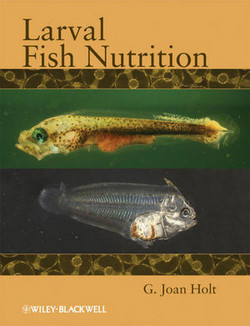
639.3/.H.L
Larval Fish Nutrition
By
G. Joan Holt
Preface
Addressing the challenges of larval fish nutrition is complex but necessary in order to make progress in developing diets for optimum growth and development of the early life stages of fish. There are two main approaches to feeding larvae in captivity: the first utilizes live food organisms such as rotifers and brine shrimp, while the second focuses on the development of microparticulate diets. Live foods are difficult to sustain, require considerable space and expense, and may not provide adequate nutrition, while microparticulate diets are easier to maintain and have lower production costs, but have not proven to be successful for raising marine fish larvae. Ingestion, digestion, and assimilation are all critical steps in the utilization of larval diets, and each or all may contribute to the lack of success thus far. Fish larvae reared on microparticulate diets generally have lower growth and survival rates that may be the result of inadequate nutritional quality of the diets, low ingestion rates, or poorly developed digestive systems in the larvae, and the dependence on live food, has hindered progress in developing larval diets. Since larviculture is a bottleneck to successful production of many preferred, high-quality marine species, it is important to know where we should be headed to successfully develop diets for fish larvae. Development of artificial feeds for fish larvae capable of supporting good survival and growth would be a tremendous benefit to hatcheries that depend on the supply of live feed. This book on larval fish nutrition was developed to address these challenges and support the development of feeding and weaning strategies that will optimize growth and survival of fish for production.
The aim this book is to provide a comprehensive reference text on larval fish nutrition. It includes sections on digestive development and nutrient requirements, nutrient physiology, and feeds and feeding. Each of these three sections details crucial topics, including ontogeny of the digestive system; Current state of knowledge on the requirements for lipids, proteins, and micronutrients; Effects of brood stock diet on eggs and larvae; Utilization of yolk during endogenous feeding; effects of nutrition on development; metabolism and bioenergetics; regulation of digestion; feeding behavior and live feeds; microparticulate diet technology, testing, and evaluation; and methods for assessing growth, and the potential of the zebrafish as a model organism to study fish nutrition. Reference tables of development events, micronutrients in live prey, fatty acid requirements, vitamin requirements for broodstock, and so on are included. A list of challenges and solutions is provided, along with suggestions for evaluating their success. A strong team of international experts in each of the important areas of larval fish nutrition was assembled to summarize current knowledge and to suggest essential future directions. A total of 34 contributors from Denmark, Europe, Israel, Norway, Mexico, the United Kingdom, and the United States provided summaries of critical information needed to promote rapid progress in this field. It is hoped that this book will be a beneficial reference for researchers advancing knowledge of larval fish nutrition and aquaculture production, as well as a valuable supplementary textbook for advanced courses in nutrition, aquaculture, and larval fish studies.
Contents
Section 1: Digestive Development and Nutrient Requirements.
Chapter 1: Ontogeny of the digestive tract.
Chapter 2: Lipids.
Chapter 3: Proteins.
Chapter 4: Micronutrients.
Section 2: Nutritional Physiology.
Chapter 5: Effects of broodstock diet on eggs and larvae.
Chapter 6: Utilization of yolk: transition from endogenous to exogenous nutrition in fish
Chapter 7: Effects of larval nutrition on development
Chapter 8: Bioenergetics of growth in commercially important developing fishes.
Chapter 9: Regulation of digestive processes.
Section 3: Feeds and Feeding.
Chapter 10: Feeding behavior in larval fish.
Chapter 11: Live feeds.
Chapter 12: Microparticulate diets: technology.
Chapter 13: Microparticulate diets: testing and evaluating success.
Chapter 14: Methods for assessing embryonic and larval growth in fish.
***For more please Visit the Library***
Prep/ Ayman Ashry
Manage/ Mona Mahmoud



ساحة النقاش